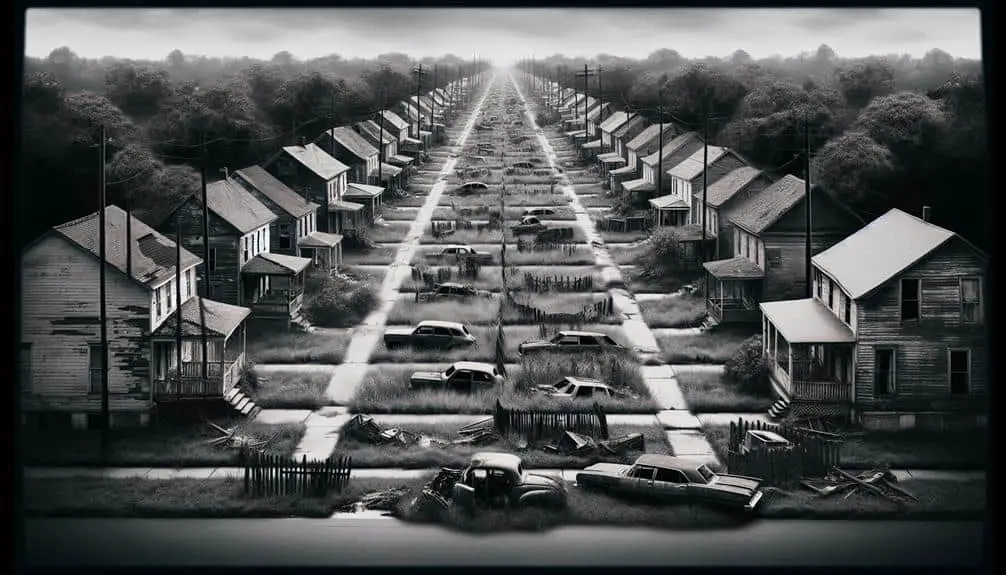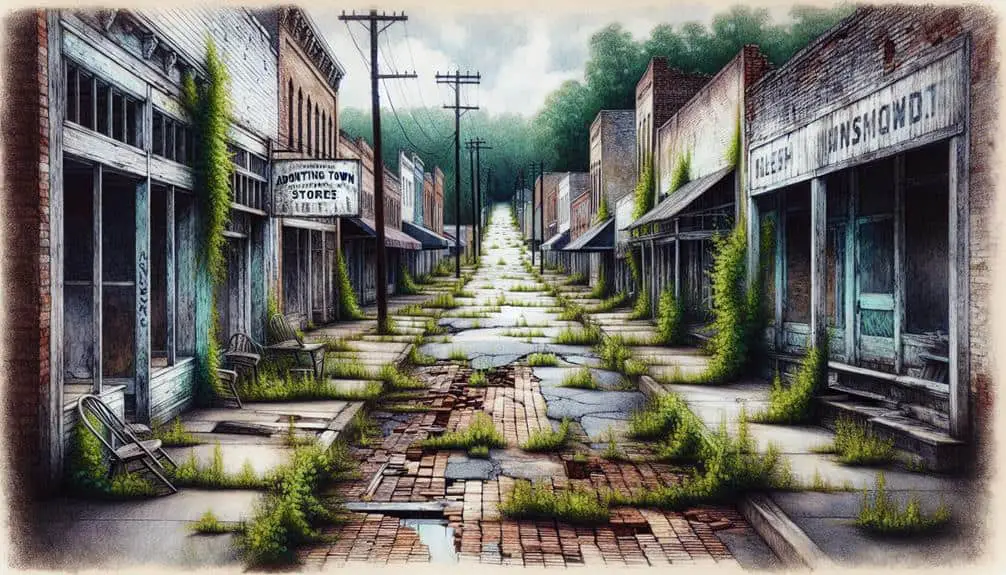Southern neighborhoods are empty due to economic struggles, historical biases, and environmental risks. Gentrification displaces long-term residents, causing social inequality. Discriminatory housing policies linger, affecting investment and population retention. Urban migration and climate challenges compound the issue, requiring strategic solutions. Revitalization demands community involvement, infrastructure upgrades, and funding collaborations to usher in sustainable change. Understanding these facets reveals the depth of the problem and how diverse efforts can breathe life back into deserted areas.
Key Points
- Economic decline leads to vacant homes and struggling businesses.
- Gentrification displaces long-term residents with wealthier newcomers.
- Historical factors like colonial legacy and racial segregation contribute to abandonment.
- Urban migration patterns and rural exodus impact neighborhood populations.
- Environmental challenges and disasters increase vulnerability in deserted neighborhoods.
Economic Decline Impact on Neighborhoods
The all-encompassing decline has left Southern neighborhoods deserted and abandoned, with vacant homes and struggling businesses lining the streets. This scenario isn't just a result of a downturn in the economy, but it also reflects the deep-rooted issues of gentrification effects and social inequality within these communities. Gentrification, often driven by economic forces, can lead to the displacement of long-term residents and the erosion of the social fabric that once defined these neighborhoods.
The impact of gentrification effects on Southern neighborhoods has exacerbated social inequality, creating a divide between those who can afford the rising costs of living in revitalized areas and those who are pushed out due to financial constraints. As a result, the once vibrant communities have become ghost towns, with wealthier newcomers replacing the original inhabitants.
To address these challenges, a holistic approach that prioritizes affordable housing initiatives, equitable economic development, and community empowerment programs is essential. By fostering an environment that values inclusivity and diversity, Southern neighborhoods can mitigate the negative effects of gentrification and work towards creating a more sustainable and thriving future for all residents.
Historical Factors in Abandonment
Historical factors play an essential role in the abandonment of Southern neighborhoods, shaping their present-day landscape and influencing the trajectory of community development. The colonial legacy in the South, characterized by a history of slavery, exploitation, and unequal land distribution, has had lasting effects on the urban fabric. Racial segregation, enforced through discriminatory housing policies like redlining, restricted African American communities to certain neighborhoods, limiting their access to resources and opportunities.
The legacy of racial segregation continues to impact Southern neighborhoods today, contributing to economic disparities, disinvestment, and social fragmentation. As a result, many communities struggle to attract investment and retain residents, leading to abandonment and decline. Understanding the historical roots of these issues is important for implementing effective solutions that address systemic inequalities and promote inclusive, sustainable development.
Urban Migration and Population Shifts
Urban migration patterns in Southern neighborhoods reflect a complex interplay of economic, social, and environmental factors, driving significant population shifts over time. The phenomenon of rural exodus, where people move from rural areas to urban centers seeking better opportunities, has fueled urban growth in the South.
Demographic changes and social dynamics also play a pivotal role in reshaping these neighborhoods. Younger generations often seek urban areas for education, employment, and cultural experiences, leading to a concentration of youth in cities. This shift in population has implications for community development, infrastructure needs, and resource allocation.
Understanding the reasons behind these migration patterns is essential for policymakers and urban planners to create sustainable solutions to accommodate the influx of residents. By analyzing data on migration trends and studying the social factors influencing these movements, strategies can be developed to revitalize abandoned Southern neighborhoods and create thriving urban centers that meet the evolving needs of the population.
Environmental Challenges and Disasters
Facing mounting environmental challenges and the looming threat of disasters, Southern neighborhoods must prioritize proactive measures to guarantee resilience and sustainability in the face of adversity. Climate change poses a significant risk to these communities, leading to increased frequency and intensity of natural disasters such as hurricanes, floods, and wildfires. Data shows that these neighborhoods are particularly vulnerable due to factors like poor infrastructure, lack of green spaces, and limited access to resources.
To address these challenges effectively, Southern neighborhoods need to invest in robust disaster preparedness programs, implement sustainable urban planning strategies, and enhance community resilience initiatives. By integrating climate adaptation measures into urban development plans and promoting ecosystem restoration projects, these communities can mitigate the impact of environmental hazards and improve overall quality of life.
Emphasizing the importance of early warning systems, emergency response training, and sustainable land use practices is vital for fostering a culture of preparedness and resilience among residents. By taking proactive steps to address environmental challenges and build adaptive capacity, Southern neighborhoods can create a safer and more sustainable future for generations to come.
Revitalization Efforts and Future Prospects
In light of the challenges faced by Southern neighborhoods, a strategic approach to revitalization efforts and future prospects is essential for sustainable development. To achieve this, focusing on community engagement and infrastructure improvements will be key:
- Community Engagement: Encouraging residents to participate in decision-making processes can foster a sense of ownership and pride in their neighborhoods. This involvement can lead to more tailored revitalization plans that meet the specific needs and aspirations of the community.
- Infrastructure Improvements: Upgrading essential infrastructure such as roads, public transportation, and utilities is vital for attracting investment and improving the overall quality of life in Southern neighborhoods. These improvements can enhance connectivity, accessibility, and safety, making the areas more appealing for residents and businesses.
- Partnerships and Funding: Collaborating with local organizations, businesses, and government agencies to secure funding for revitalization projects can amplify the impact of these efforts. By leveraging external resources and expertise, Southern neighborhoods can accelerate their revitalization process and create sustainable change for the future.
Frequently Asked Questions
How Do Cultural Factors Play a Role in the Desertion and Abandonment of Southern Neighborhoods?
Cultural influences shape behaviors in deserted neighborhoods. Economic disparities exacerbate the situation. Understanding these factors can lead to targeted interventions that empower communities, fostering revival and sustainability in once-abandoned areas.
Are There Any Unique Architectural Features or Styles That Are Being Lost as These Neighborhoods Are Abandoned?
You might wonder if unique architectural features in abandoned southern neighborhoods are vanishing. Preservation efforts could salvage historical treasures. Act now to protect these gems before they're lost forever. Your action can make a difference.
What Impact Do Social Services and Community Resources Have on the Decision to Stay or Leave a Southern Neighborhood?
To decide to stay or leave a southern neighborhood, consider the impact of social services and community resources. Access to education and job opportunities influences your choice, while community engagement and mental health support play crucial roles.
How Are Local Governments and Organizations Addressing the Issue of Vacant Properties in These Neighborhoods?
To address vacant properties in southern neighborhoods, local governments and organizations are prioritizing economic revitalization through property rehabilitation and urban planning. Community engagement plays an essential role in creating sustainable solutions for these areas.
What Role Do Transportation and Infrastructure Challenges Play in the Decision to Abandon Southern Neighborhoods?
Transportation barriers can hinder access to jobs and services, impacting neighborhood abandonment. Infrastructure development, such as improving roads and public transit, can revitalize these areas, making them more attractive for residents and businesses.



